RED ARMY TIGHTENS STALINGRAD NOOSE
Outside Stalingrad, Southern Russia • January 10, 1943
The contest between the German Wehrmacht (armed forces) and the Red Army for possession of Stalingrad (August 23, 1942, to February 2, 1943) proved to be the most strategically decisive battle on Germany’s Eastern Front and arguably of World War II. Known today as Volgograd, Stalingrad (population 400,000) occupied the west bank of the Volga River, a major commercial artery to the north and the Urals to the east. It was quite naturally an important center of transshipment by rail and a center of heavy industry in Southern Russia. For these reasons it attracted the attention of Adolf Hitler.The first attacks on the city occurred in late summer of 1942 when Gen. Friedrich Paulus’ Sixth Army approached Stalingrad from the west, elements of Col. Gen. Hermann Hoth’s Fourth Panzer Army approached the city from the south, and Hermann Goering’s Luftwaffe bludgeoned the city from the air. Though the Germans eventually captured over 90 percent of the city, now reduced mostly to a rubble field, 2 small pockets of resistance and vicious street-to-street, house-to-house fighting prevented the Germans from claiming outright victory.
On November 19, 1942, the Soviets launched a 4‑day counteroffensive, codenamed Operation Uranus, which led to the encirclement of Paulus’ Sixth Army, portions of the German Fourth Panzer Army, and the Third and Fourth Romanian armies, which guarded German flanks. On January 8, 1943, Red Army representatives under a flag of truce made Paulus an offer of honorable capitulation, guaranteeing the lives, health, and safety of Axis POWs and their return after the end of the war. However honorable the terms, Hitler nixed them, psychopathically fixated on the city that bore his archenemy’s name (“I won’t leave,” he screamed) and consequently stubbornly blind to the wasted city’s diminished strategic significance.
Two days later, on this date, January 10, 1943, the Soviets launched Operation Ring, tightening the deadly noose around a quarter-million Axis soldiers, low on food, ammunition, and morale. In bitter fighting the Soviets gradually pushed the enemy from the city center into a northern and a southern pocket. Paulus and his headquarters (a department store basement) in the southern pocket ceased fighting on January 31, and the northern pocket ceased organized resistance on February 2, 1943.
Significantly, the 5-month Battle of Stalingrad resulted in the destruction of the entire German Sixth Army (400,000 men initially) and elements of the Romanian Third and Fourth armies (158,854 soldiers killed, wounded, and missing), the Italian Eighth Army (20,800 soldiers killed and 64,000 captured), and the Hungarian Second Army, which suffered 80 percent casualties. By contrast, Soviet casualties were well over 1.1 million. So reduced was the Wehrmacht by its losses on its Eastern Front that the initiative began to shift to the Soviets. By the end of year, 1943, following a string of victories by a rejuvenated Red Army and air force, it was clear that Nazi Germany would not only lose the war in the East but would also lose World War II.
Battle of Stalingrad, August 23, 1942, to February 2, 1943
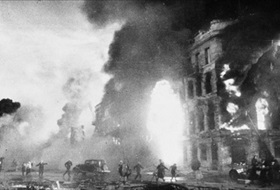 | 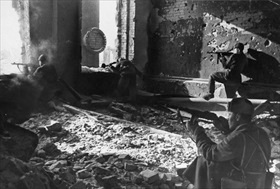 |
Left: Beginning on August 23, 1942, the Luftwaffe bombed Stalingrad block-by-block for 5 straight days. Firestorms killed anywhere from 25,000 to 40,000 people. After August 25, the Soviets stopped recording civilian and military casualties as a result of air raids. The Luftwaffe also rendered the River Volga, vital for ferrying supplies into the besieged city, unusable to Soviet shipping. Photo from late August 1942.
![]()
Right: Stalingrad’s desperate defenders realized that their best defense consisted of anchoring their defense lines in numerous buildings. Thus, they converted multistory apartment houses, factories, warehouses, corner residences, and high-rise office buildings into strongholds bristling with machine guns, antitank rifles, mortars, mines, barbed wire, snipers, and small 5–10 man units of submachine gunners and grenadiers prepared for house-to-house, hand-to-hand combat. The Germans called this ever-present, often unseen urban warfare Rattenkrieg (“Rat War”). They bitterly joked about capturing the kitchen but still having to fight for the living room and the bedroom.
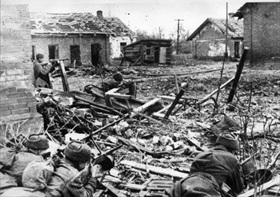 | 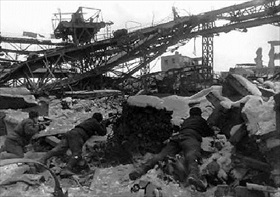 |
Left: A group of Soviets prepares to ward off a German assault in Stalingrad’s shattered suburbs. Prior to the November 19, 1942, Soviet counteroffensive, Red Army and German soldiers sometimes fought for days over a few square yards/meters of territory.
![]()
Right: Soviet soldiers crawl in the rubble of the Red October Steel Factory, the scene of fighting through much of the siege. The original German advance had almost overrun it and reached the Volga. The Red Army held. Later, as snow settled on the wrecked factory, the Soviets won it back.
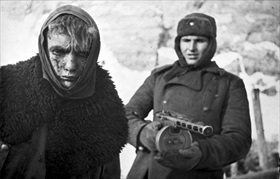 | 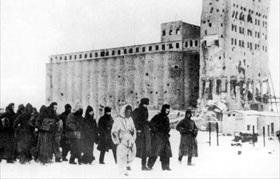 |
Left: Bundled against the cold, machine gun in hand, a Red Army soldier marches an exhausted German soldier into captivity. A handful of captured senior German officers was taken to Moscow and used for propaganda purposes, and some of them joined the National Committee for a Free Germany (NKFD), a German anti-Nazi organization that operated in the Soviet Union during the war. Some higher-ups, among them Paulus, whom Hitler had made Field Marshal hours before the German surrender at Stalingrad, joined the NKFD and signed anti-Hitler statements that were broadcast to German troops. Paulus testified for the prosecution during the postwar Nuremberg Trials. He remained in the Soviet Union until 1952, then moved to Dresden in Communist East Germany, where he died in 1957, exactly 14 years after surrendering the German Sixth Army.
![]()
Right: German troops as prisoners of war, 1943. In the background is the heavily fought-over Stalingrad grain elevator. Out of the nearly 110,000 battle-weary German prisoners captured in Stalingrad, only about 6,000 ever returned home. Already weakened by disease, starvation, and lack of medical care during their encirclement, they were sent on death marches (75,000 died within 3 months of capture) to POW camps and later to labor camps all over the Soviet Union. Some 35,000 were eventually sent on transports, of which 17,000 did not survive. Most POWs died of wounds, disease (particularly typhus), cold, overwork, mistreatment, and malnutrition.
Battle of Stalingrad: Death of an Army
![]()

 History buffs, there is good news! The Daily Chronicles of World War II is now available as an ebook for $4.99 on Amazon.com. Containing a year’s worth of dated entries from this website, the ebook brings the story of this tumultuous era to life in a compelling, authoritative, and succinct manner. Featuring inventive navigation aids, the ebook enables readers to instantly move forward or backward by month and date to different dated entries. Simple and elegant! Click
History buffs, there is good news! The Daily Chronicles of World War II is now available as an ebook for $4.99 on Amazon.com. Containing a year’s worth of dated entries from this website, the ebook brings the story of this tumultuous era to life in a compelling, authoritative, and succinct manner. Featuring inventive navigation aids, the ebook enables readers to instantly move forward or backward by month and date to different dated entries. Simple and elegant! Click 











